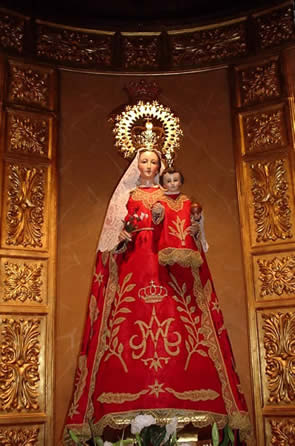 Third Sunday in November
Third Sunday in November
Virgen de la Peña, Fustiñana, Tudela, Navarre, Spain
In the Ebro River valley of northern Spain, the small town of Fustiñana honors its patron saints in a big way. There are three: the schoolboy martyrs Justus and Pastor, celebrated August 6, and the Virgin of the Crag, whose fiesta takes place on the third Sunday of November. Each year different people have the honor of serving as majordomos of the Virgin's festivities. In early autumn, the majordomos conduct a door-to-door auction of a piece of her mantle to raise funds for maintenance of her shrine and for all the ceremonies of the year. After a nine-day novena in November, on the eve of the fiesta, they open the celebration by lighting a bonfire with torches in the town square. Together with the mayor and the priest, the majordomos throw bushels of walnuts from a city hall balcony to the people below. Then there are fireworks and sharing of the Virgin's special wine. The majordomos take walnuts and wine to shut-ins who can't attend. Sunday's celebration begins early with the singing of auroras, dawn greetings. Later there's a mass, a procession, and singing of jotas, traditional songs in waltz time; and at night, another bonfire and fireworks. On Monday, people return to the square for ranchos, the sharing of a special stew prepared by over 100 families with ingredients provided by the town. On Tuesday the festivities end with games and a meal for the children.These traditions go back a very long way; the origin of the devotion is uncertain. Fustiñana's Virgin seems unrelated to either the famous Virgen de la Peña de Francia in Salamaca province or to any legend of a Marian encounter on a local peak. For centuries she has been invoked in times of too much or too little rain. Though her image appears on the town crest and has a place of honor in the Church of the Assumption and during the fiesta, it is relatively unimportant, compared to the "miraculous" images of other Marian devotions. The current statue dates from 1902; the medieval statue and that of 1597 by Basque sculptor Bernal de Gabadi still exist, without much veneration. The power of the Virgen de la Peña in Fustiñana lives in its people and in the ways they continue to bring her into their community as a living participant.
Sources include:
| Amara Arrondo, "FIESTAS DE LA VIRGEN DE LA PEÑA 2009," Nov. 18, 2009, La Tiza Digital (student website of Sts. Justin & Pastor Public School), www.latizadigital.com/index.php?S=16&pag=5 | |
| atlas-Fustinana-Tudela, www.lebrelblanco.com/anexos/atlas-Fustinana-Tudela.htm (picture) | |
| "Fustiñana," document, www.fustinana.com | |
| "Las nueces, en las fiestas de la Virgen de la Peña," Nov. 18, 2011, Diario de Navarra, www.diariodenavarra.es |
Also commemorated this day:
| Nossa Senhora de Nazaré, Acará, Pará, Brazil. Círio in parish hall. | |
| Nossa Senhora de Nazaré, Primavera, Pará, Norte, Brazil. Círio. Street procession. |
| Nuestra Señora de los Remedios, Malate, Manila, Philippines. Procession, original 1600s image that survived WWII bombing displayed. | |
| Patronage of Mary, Papal States (c1340-1870) |